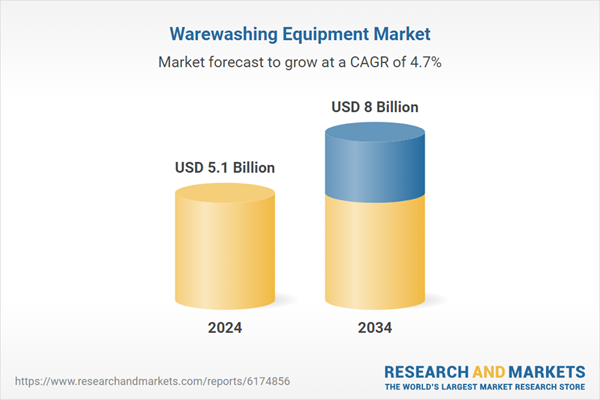Market expansion is being shaped by a mix of evolving food service dynamics and consistent innovation in cleaning technologies. With restaurants, hotels, and food service facilities increasing in both urban and semi-urban areas, demand for high-capacity, energy-efficient warewashing solutions is on the rise. As these industries focus more on customer satisfaction, hygiene standards, and operational speed, there's a greater shift toward technologically advanced machines that can handle larger volumes with precision and reliability. Automated systems, IoT integration, and sensor-driven maintenance tools are becoming standard, making warewashing systems more intelligent and responsive. Commercial kitchens and multi-location restaurant chains are prioritizing consistent cleanliness across operations, creating demand for machines with standardized, programmable settings. These systems not only improve hygiene but also reduce labor dependency, particularly vital in regions with high labor costs or workforce shortages. The combination of rising consumer expectations, stricter regulations, and the need for faster service is driving the warewashing equipment industry into a new phase of intelligent automation and sustainable design.
The dishwasher segment generated USD 2.5 billion in 2024 and is forecasted to grow at a CAGR of 4.9% through 2034. Among all warewashing systems, dishwashers continue to be the most used due to their versatility, ease of operation, and efficiency. Their ability to wash a broad range of items, from utensils to trays, makes them a preferred option in various commercial settings, including food prep centers, hospitality, and institutional kitchens. Compared to other warewashing solutions, dishwashers serve as multi-functional workhorses that handle bulk operations without compromising hygiene or efficiency.
In 2024, the fully automatic equipment segment held a 54.34% share and is expected to grow at a CAGR of 4.9% through 2034. Fully automated warewashing machines have become increasingly essential in large-scale operations due to their ability to handle substantial volumes of kitchenware with limited manual input. These systems deliver speed, reliability, and regulatory compliance in demanding environments. Commercial kitchens, hospitals, and institutional cafeterias especially favor these machines because they minimize human error, improve sanitation, and support operational consistency while meeting modern efficiency standards.
United States Warewashing Equipment Market held a 78.7% share and generated USD 1.4 billion in 2024. The growth in this region is largely driven by a mature hospitality and foodservice sector, where labor costs remain high and compliance with stringent hygiene regulations is mandatory. Automated warewashing systems have gained strong traction in response to operational cost pressures and regulatory mandates. Additionally, the ongoing shift toward sustainability has prompted foodservice operators to adopt energy- and water-efficient machines that align with cost-saving and environmental goals. Businesses increasingly prioritize equipment that reduces utility consumption while enhancing performance, helping to streamline workflow and support green initiatives.
Key players shaping the Global Warewashing Equipment Market include Meiko, Washtech, Hobart, Fagor Industrial, Electrolux Professional, Classeq, Sammic, Ecolab, Winterhalter, Champion Industries, Insinger Machine Company, Smeg Foodservice Equipment, Comenda, Krupps, and Jackson Warewashing Systems. To secure long-term market positioning, companies in the warewashing equipment industry are heavily focused on product innovation, energy efficiency, and technological integration. Leading manufacturers are developing machines equipped with smart diagnostics, touch-screen controls, and remote monitoring capabilities to support predictive maintenance and reduce downtime. Automation remains a primary focus, especially for high-volume operators looking to streamline operations with minimal labor input. Sustainability is another critical area, with firms designing systems that reduce water and energy use while maximizing cleaning efficiency.
Comprehensive Market Analysis and Forecast
- Industry trends, key growth drivers, challenges, future opportunities, and regulatory landscape
- Competitive landscape with Porter’s Five Forces and PESTEL analysis
- Market size, segmentation, and regional forecasts
- In-depth company profiles, business strategies, financial insights, and SWOT analysis
This product will be delivered within 2-4 business days.
Table of Contents
Companies Mentioned
The key companies profiled in this Warewashing Equipment market report include:- Champion Industries
- Classeq
- Comenda
- Electrolux Professional
- Ecolab
- Fagor Industrial
- Hobart
- Insinger Machine Company
- Jackson Warewashing Systems
- Krupps
- Meiko
- Sammic
- Smeg Foodservice Equipment
- Winterhalter
- Washtech
Table Information
| Report Attribute | Details |
|---|---|
| No. of Pages | 242 |
| Published | September 2025 |
| Forecast Period | 2024 - 2034 |
| Estimated Market Value ( USD | $ 5.1 Billion |
| Forecasted Market Value ( USD | $ 8 Billion |
| Compound Annual Growth Rate | 4.7% |
| Regions Covered | Global |
| No. of Companies Mentioned | 16 |









